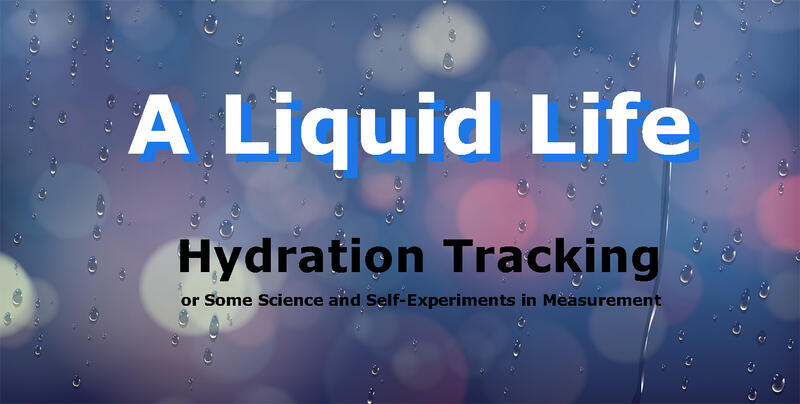
My body felt flat and my mind was off. This run wasn’t going as planned. I wasn’t exactly thirsty since I had been drinking water since the start, but my body wasn’t responding well. I had woken up late or, better said, went to bed late after a late-night client call. It was sunny and warm and I wanted to run with it.
The sun was up when I finally got up and on the road at 9am. It was getting humid and hot already. Perhaps over 25C outside in the sunny parts. I had my gear and even my water-backpack. I was aiming for a 13k (8mi) run over an hour. But my body and conditions soon dictated otherwise. My mind and body weren’t right.
So, I slowed down considerably, took a couple breaks and cut my run down to one of my standard routes: 7.5k run. over 49:34 at a pace 6:36. I had run too fast in these conditions. For a medium run like this, the effects were noticeable: general weakness, slight dizziness, heart palpitations, confusion and sweating. I was dehydrated.
Whether you are a runner or hydration has an important effect on all of our lives. In my case, this hot day run left me tired in a different way. The rest of the day I was off and even the next day I didn’t feel great. The obvious lesson as a runner was that I needed to run earlier on a hot day and if I was going to run in the heat, I needed to slow down to run without danger.
The broader lesson for me was an exploration about hydration, tracking what I drink and even a few experiments to help improve my exercise and everyday life with different drinks.
In this post we are going to look briefly at hydration. We will look at the science of hydration and some numbers scientists point to in terms of how much water you should drink. As our main goal is “tracking everything,” we will then look at why and how to track hydration. There are surprisingly a lot of apps and tech for tracking hydration and liquid consumption, but I think the main challenge before you even start is figuring how the measurements of your drinking vessels. Once you know, it’s easy to log your water and other drinking through apps like iHydrate and Waterlogged. Finally we will look at some of the key takeaways I’ve learned about tracking hydration.
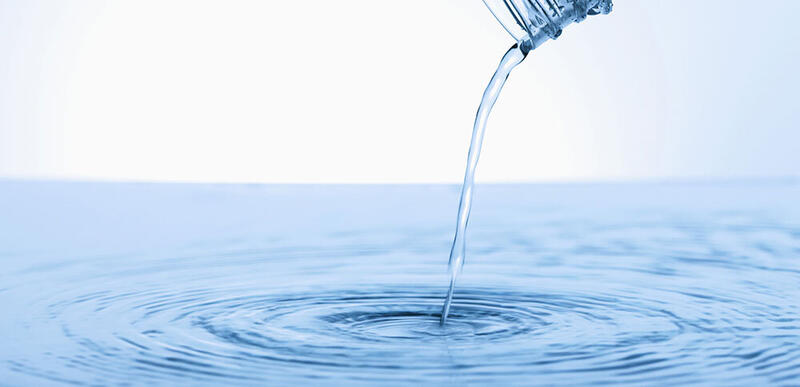
Science of Hydration:
Nearly all of our major bodily systems depend on water. While you can survive several weeks without food (though it isn’t recommended!), you’ll perish after three days without water. This shortens even hot, extreme conditions like a desert.
Considering that over 65 percent of our body is made of it, water is essential to humans. Here are some ways: water lubricates joints, helps regulate temperature, helps kidneys and liver process wastes, helps body dissolve minerals and other nutrients, carries nutrients and oxygen to different parts of the body, and keeps our orifices moist like our nose, mouth, and eyes among other things.
As a runner or someone who is physical active, being even slight hydrated can take an added toil on your joints. Pounding on pavement or lifting weights without proper hydration can cause damage and limit your performance. So, it’s important to drink before and during your workouts.
While Gatorade and other sugar drinks do a lot of advertising, the reality is that elite athletes don’t use these that much. Instead, they supplement their water with salts. Adding salts help when you are particularly sweaty and anecdotally know to improve performance and training. Personally I’ve found that Nuun Tablets have been helpful before and after long training sessions. They provide various salts as well as caffeine for a small boost. I’ve heard good things about Osmo Nutrition too.
It’s common knowledge the importance of hydration for your health, but lesser well-known is the cognitive effect of staying hydrated. As reported by Medical Daily, researchers in the UK conducted an experiment on participants who did not eat or drink the night before. They found that “providing a glass of water immediately before the participants took the exam boosted mental reflexes, specifically reaction time, by 14 percent.”
Personally, it doesn’t take a science experiment to see this personally. Try working on a hard cognitive tasks like writing, studies or something else with and without water. You’ll notice a difference. Drinking water and caffeine changes your focus and productivity.
Overall, the basic science of hydration is simple: you need to drink enough water or you body and its performance suffers. In the case of sports, dehydration can be dangerous, as I discovered on one summer run recently.
How Much Water Should I Drink? 8 Glasses a Day Really?
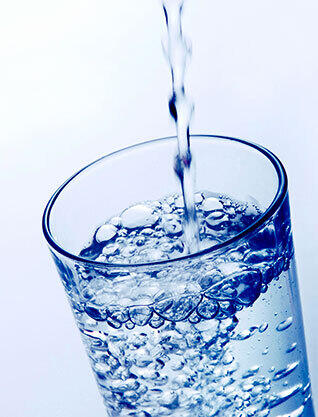
We’ve been told for ages to drink at least 8 glasses of water day. It’s one health recommendation we all seem to know. It’s not entirely false or true, and its origin story is an interesting one.
As explained by OneMedical:
“this 8×8 rule likely originated from a misinterpretation of an outdated recommendation from 1945 when the Food and Nutrition Board — now part of the Institute of Medicine (IOM) — suggested that a person consume one milliliter (ml) of water per each calorie of food consumed. Thus, an average diet of 1,900 calories per day would dictate an intake of 1,900 ml (approximately 64 ounces) of water. However, people interpreted this as a recommendation to drink 1,900 ml of pure water, forgetting the fact that water is also found in abundance in the other liquids and foods we consume.”
Subsequent studies when farther in debunking this one. For example, according to WebMD, a “2002 study published in the American Journal of Physiology questioned the old recommendation of 8 ounces of water, eight times a day. After a thorough review, researcher Heinz Valtin concluded there was inadequate evidence that healthy adults – living in temperate climates and not engaged in rigorous activities – need large amounts of water.”
So, for most healthy people, you don’t need to worry about adhering to this rule of 64-ounces of water day. Instead the recommendation is from the Institute of Medicine (IOM) is use to thirst to determine your fluid needs.
There are a few exceptions to this drink-when-thirsty baseline and it includes people with a medication condition requiring fluid control, for athletes and for people planning to spend a lot of time outdoors or extreme conditions.
In spite of the obviousness of this thirst guideline, what about getting to a number? What does the science recommend? How much is enough water per day?
While they no longer recommend simply your water intake, the IOM does provide some recommendations on total daily fluid intake. For men, they recommend 125 fluid ounces or about 3700 milliliters, and for women 90 fluid ounces or 2600 ml. These are pretty general numbers and it largely depends on you, where you are, and your activities. That said, I think 2000 or so ml per day is a baseline number to work with when you start tracking your fluids.

Why Track Your Hydration
I’ve been tracking a lot of data points over this past year. The pursuit of self knowledge can lead you in a lot of directions. Some of these tracking experiments are quite meaningful while others are one-off curiosities. Time, habits and task tracking remain essential to me as does tracking my exercises and steps. Location tracking has provided some interesting insights and context for stories. Tracking how often I pee, shave or poop gave me numbers but I’m unlikely to modify my behavior to make them significant.
Similarly while I also track my music and podcast listening and TV and movie watching, these are are part of my efforts in self-tracking as a process full life logging. I also log the books I read and articles. All combined I have a pretty complete portrait of the information I touch and have created my own digital archive.
Eventually my goal to “track everything” lead me to food and water. I’ll admit that tracking food and beverages are some of the harder areas to track. You have to be diligent and tracking these events leads to cases of technology getting in the way of doing what you are doing. When you start tracking, drinking a coffee requires a moment to track it.
Time tracking and music tracking, for example, are passive background process, but tracking your food or water requires you to pause, get out your phone and check-in something before, after or during the event. It takes a specific moment in time to track. You can’t really track these areas seamlessly.
As a self-tracker, I’ll admit that I put a lot of my free time and extra moments to tracking. I’m not a gamer so I can claim that tracking my life has turned my real life into a “virtual pet.” I collect data and can keep score in a way. So for me I started tracking my hydration to explore a new area.
I think there are other valid reasons to track your drinking. These include understanding when you drink during the day and figuring out how much of different things you are drinking for health reasons like sodas, coffee and alcohol. If you are like me and tracking is an express of personal optimization and self-improve, tracking your hydration and slight dehydration can create a better you.
In my case, I’ve come to realize how empowering consistently starting my day with a big glass of water can be. It’s hard to wake up sometimes, so having a glass of water nearby can take away a bit of that fatigue.
How To Track Your Hydration: My Initial Efforts with Nomie
My first efforts to track water and food were part of a wider experiment in tracking a bunch of data points. Using Nomie, a flexible life logging mobile app, I was able to use a series of buttons to log a bunch of aspects of my life.
From Oct 20 to Nov 7, 2016, I logged between 25 to 13 items per day, including several non-drinking data points like healthy vs unhealthy meals and healthy vs. unhealthy snacks. Here is the breakdown:

When it came to hydration, I wasn’t tracking the actual amount consumed but instead focused on the types of drinks and when I drank throughout the day. In terms of drinks, I tracked the following items: Water, Tea, Coffee, Beer, and Soda.
I logged (and by extension, drank) between 7 and 13 items per day over this period and for an average of 9.3 drinks per day.
From these data points, I was able to reconstruct a day in drinking that looked like this:
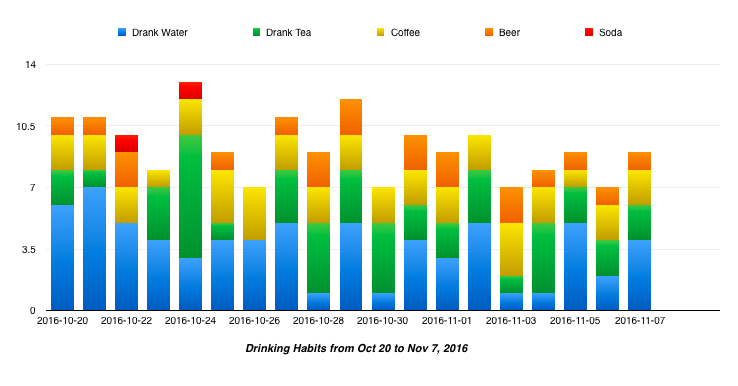
Similarly I’m able to peer back and see how much water as such I was drinking in comparison to non-water drinks:
![]()
While this form of tracking hydration didn’t log in milliliters, it did help me map out my drinking routines, including geographically where of it was logged as well as generally what part of the day. As should be no surprise, I drank coffee each morning and beer at night. Here are a few additional charts for looking at this, thanks to Zenobase:

While obviously this form of hydration tracking doesn’t capture everything, the ease of getting this data in and out makes for some interesting discoveries. I could see when I drank coffee and teas rather than exactly how much caffeine. By looking at coffee and pooping, I saw in the data a pretty high correlation, i.e. coffee does make me poop!
Figure Out Your Measurement
Following this experiment in general life logging, I decided it was time to do a full out experiment in measuring how much I was drinking. I want to fully track my hydration levels. The first problem was how to measure it?
We drink from various types of cups and glasses, but if you are anything like me, it’s likely you have no idea how many fluid ounces or milliliters are in your typical drinking vessels. So, before you can start tracking your hydration with an app or otherwise, you need to know your measurements.
First off, I recommend you limit yourself to a couple of common glasses of cups you will use during this experiment. In my case, I have one big glass and smaller glass.
Second, in order to measure how much liquid they hold, there are a couple ways to do it. If you have measuring cups of cooking, then you are in luck and can quickly note how much water each of your daily cups contains.

In my case, I used a simple “hack” to figure out my measurements. With some simple arithmetic and a bottle of water I bought. Using a 570 ml water bottle, I filled each glass multiple times in succession until I emptied the bottle. In this way, I was able to generate some numbers around how much water is in the different vessels I use for drinking. For example, small glass was filled 4 and 3/4 times from the water bottle, so it contained 120ml. Simiarly, I could fill my big glass twice so it contained 285 ml [570ml / 2].
This left me with three standards to measure with in most cases and the option to log other amounts exactly, like a soda, beer or juice.
I believe that not knowing your measurements is one of the main behaviors for tracking your hydration. It’s crazy to think of all of the tech for hydration tracking water bottle when you can use the set measurement on bottle of water you bought to determine the size of your typical vessels.
Now that we got our measurements, let’s look at how to log your hydration.
Tech Options for Track Your Liquids
There are three ways to track hydration: apps to log, tech bottles that auto-track and special hydration monitoring wearables.
Apps: I’ll admit that I was surprised with the number of apps for tracking hydration. A lot of them had recent updates, and several were brand new. Clearly, at least from a developers perspective, there was a need for these type of apps.
Auto-Sensoring Bottles: Similarly, I discovered a lot of high tech water bottle that track your drinking. Just do a google image search to get a rough idea of how many companies are out there creating products in this space. Most of them use some sort of sensor to track changes in your bottle and connect via bluetooth to log your drinking. Unfortunately a lot of mixed reviews on the success of these different implementations.
Hydration Monitoring Wearables: The next stage of hydration tracking likely will be wearables. As fitbit went from simple pedometer to a heart rate monitor, I believe we will see smart watches and activity trackers that not only track your movements, sleep and heart but also how hydrated you are. There are already a few on the market like (Halo Edge)[https://www.halowearables.com/] and LVL recently raised over 1 million usd on kickstarter.
Like a lot of my experiments in self-tracking, my first approach is mobile tracking.
Apps to Track Hydration: iHydrate, WaterLogged, and Apple Health
If you are interesting in tracking your hydration it makes sense to log your drinking via an app. From my research and testing for iOS and iPhone, I found that my favorite hydration apps were: iHydrate, WaterLogged and, if you could use one less app, manual logging to Apple Health directly using Workflow app.
Behind the scenes all of them are able bring your hydration logging into Apple Health. Apple Health is your data kit where all of your health data gets stored. From steps and workouts to heart rate and weight, Apple Health is the backbone of Apple’s data aggregation. So, if you are tracking your hydration, it makes sense to log this into Apple Health. This will allow you to have a single source for the data, even if you are trying different apps and approaches to log it.
iHydrate, WaterLogged, and many of the other hydration tracking apps have roughly the same features sets: You have an option to log the type and size of liquid and, after, you have a way to display your total hydration in milliliters or fluid ounces by day, week, month.
Most of these apps provide a level of customization so you can set your hydration goal, though most start with 2000ml and a few do a short questionnaire to determine your total.
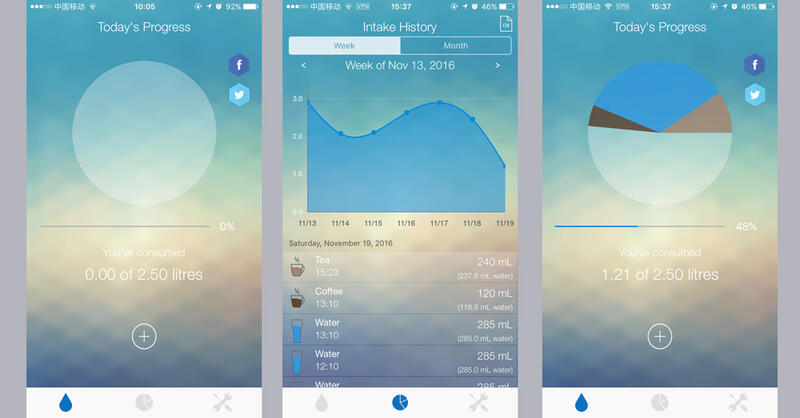
I’m a big fan of Workflow app on iOS. It’s a flexible tool to create buttons and workflows to do various things. You can use it to copy items from your camera roll to special albums or upload to different storage services. It also has a number of ways to log things into Apple Health. For example, I use it to log my mobility and stretching sessions. Instead of a separate app, I simply tap a button with the duration of my session and it goes into Apple Health.
When it comes to hydration logging, Workflow is a similarly simple solution. Using the basic workflow example it provides, I customized it to my typical measurements and added an option for custom entry. Workflow buttons appear as a special widget on the “Today” section, so you don’t even need to open an additional app to track your hydration. While there are a lot of apps for hydration, sometimes it nice to not need a new app.
By the Milliliter: A Week of Hydration Tracking
Coming off several weeks of meticulous general tracking, I wasn’t sure how well I’d be able to maintain my hydration tracking. So, instead of committing to a lifetime of logging my water and other drinking, I decided to track my hydration for a week.
I used iHydrate since it had all my basic needs as well as the option to export my data for additional analysis. Furthermore, with a bit of custom scripting, I leveraged Zenobase for much of the data analysis.
Between November 12 and November 19, I checked-in a total of 89 beverages or about 11 drinks per day, and with the added data point of volume, I was able to determine my daily hydration. I averaged 2562 milliliters per day, which is meets with the standard recommendation. Here is my breakdown over the week:
![]()
Like my previous hydration tracking I used several categories, including water, juice, coffee, and tea. This gave me a breakdown by drink and by volume over the week. I think this is one of the more meaningful charts:
![]()
This chart also shows just how much “hydration” I’m getting in the form of beer. My highest one day was 45% and lowest was 0% (no drinking day!). On average, 18% of my daily hydration was from beer. Excluding my “beer is water” day, I mostly drank water and about 54% of my hydration was in pure water. Tea was my third highest category at 17% per day on average.
Beyond the breakdown by drink type (chart on the left), it was interesting to discover when I was drinking. If you take a look at the chart of the left, you’ll see an interesting distribution:
![]()
From midnight to 8am, I drink nothing (I am sleeping!), but at the start of the day, around 9am, I have a spike in all drinking types. Subsequently I have a pretty even distribution of drinking throughout the day. This correlates with my efforts to making sure I get hydrated when I wake up and throughout the day.
Overall, while I’ll admit that logging my hydration was rather tedious, it’s interesting to look at the data afterwards. I honestly didn’t realize that so much of my hydration comes from beer. I would have guessed tea was second, after water. Similarly I didn’t realize how much hydration I typically picked up when my day started at 9 and 10am. Neither of these would know without data.
Conclusion: Some Lessons Learned on Hydration, Tracking and Self
In this post, we took a pretty broad look at the science of hydration, before digging into self-experiments in logging hydration technologies. Over two periods I logged nearly everything I drank using Nomie (a general life logging tool) and iHydrate. These lead to a clear portrait of my drinking habits and some small insights on my drinking habits.
For the time being, I am quite content with what I’m drinking and in the current quantities. I could some benefit in adding an additional day or two per week that are “alcohol free,” though I’d need to experiment to know. My current numbers are still in the same zone of a post-work, social drinker.
Recently I started drinking more tea throughout the day since I find it provides a more steady stream of caffeine and focus without the jitteriness that can come with too much coffee. I’d definitely be interested to look more into the data and science of caffeine since this is a slice of data that would be meaningful, especially in ensuring I process caffeine out before bed (and avoid poor sleep quality) and also in creating a focused and energized mental state.
For me, considerations about hydration mostly impact my sports and physical activities. I’ve now made a conscious efforts to consider the conditions when I ran and to drink a few more fluids before and after long runs. Anecdotally, I feel like being hydrated helps my knees too. Similarly, I’ve added salt tablets from Nuun that I believe help too. I’ll admit the science is weak in both of these areas still, though you can argue for the benefits.
From looking at the science, it’s clear that there are a ton of benefits to being well-hydrated and some serious dangers if we get dehydrated. I learned this the hard way on a hot, summer morning run. As I increase my running training, it’s definitely an area I need to be aware of and consider more tracking, especially once summer returns and if I ever attempt an Ultra.
Since tracking my hydration, I’ve learned some simple lessons. Firstly, serious athletic training, especially in heat, requires thinking about staying hydrated. Second, start your day with water since 8 or so hours of sleep is when you lose a lot of water. Third, your daily well-being can be improved by a simple strategy of having water and other liquids available as you work and eat. Fourth, tracking your hydration is a bit extreme.
Personally, I don’t plan to continue to track my hydration on a regular basis for now. Periodic tracking has its benefits, especially if you want to look at general patterns and tendencies. In the case of hydration, I now have data and some interesting breakdowns.
In spite of all the apps and tech around hydration, the science of hydration offers a pretty simple point about being hydrated: “Rather than religiously documenting every ounce of fluid intake, the IOM advises drinking liquids with your meals and to make sure you heed your body’s request for water by drinking when you feel thirsty. This, under most circumstances, will provide you with your daily water needs.” So, just drink when you are thirsty!
Obviously, no single week or period of tracking can fully match your yearly trends or account for exceptions, but in this case, I’m confident that this was a fairly typical period in terms of drinking, eating and activities. As such, it’s fair to extrapolate this to how much I have been drinking this past year.
Numbers are fun, so let’s end with some. Assuming I drink about 1367 ml of water per day. That means I will have drunk nearly 500 liters of water in a year, and assuming I keep drinking beer at my current rate (which feels like an off week, I’ll admit), I’ll have drunk 175 liters of beer in a year.
Hopefully this article offered you some things to think about and try. Good luck with your hydration and happy tracking!
